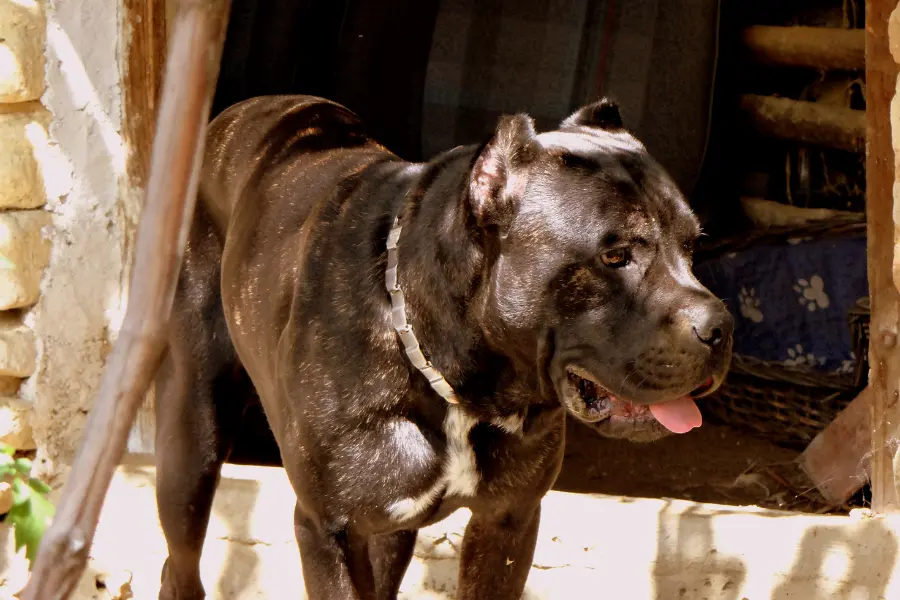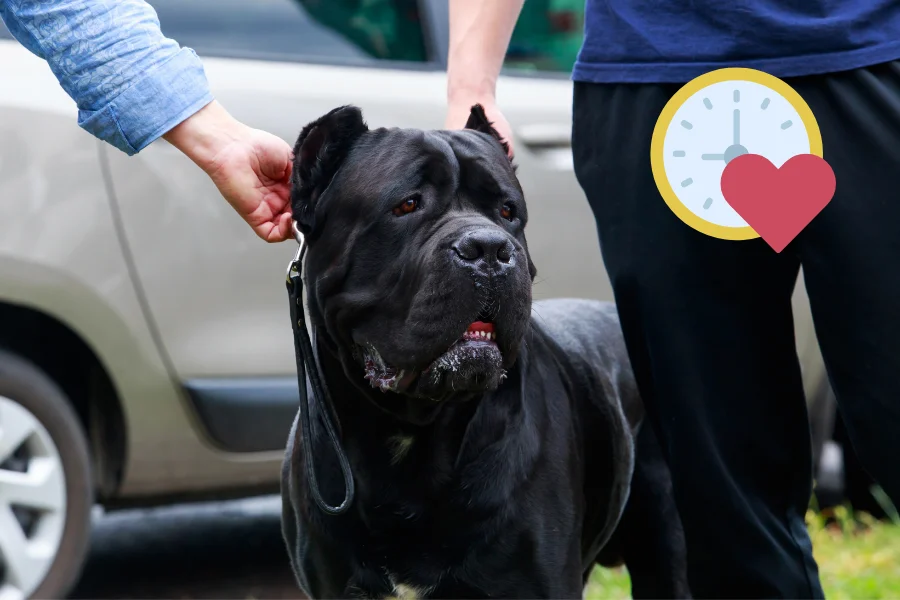Cane Corsos are generally healthy dogs, and if you get your puppy from a responsible breeder who screens his pups for health conditions, you can somewhat predict if your Corso will live a long and healthy life. But what’s the actual lifespan of a Cane Corso?
The average lifespan of a Cane Corso is between 8 and 12 years of age. This may not seem very long, but like most large size dog breeds, Cane Corsos have a shorter lifespan than small dog breeds.
This is the same age number that’s in every dog encyclopedia and every dog website, but I wanted to find an actual study with actual Cane Corso owners, with actual survey results, and I did…
Cane Corso Lifespan Survey Results
The study on the longevity of Cane Corsos reports a median lifespan using the data of 232 Cane Corsos collected from kennels and individual owners across 25 countries. They were asked to complete a survey containing questions like: name, sex, coat color, age of death, cause of death.
The median lifespan of the whole survey group of Cane Corsos is 9.29 years.
| Coat Color | Median Age | Corsos(n) |
|---|---|---|
| Black Brindle | 10.30 | 35 |
| Brindle | 10.13 | 38 |
| Gray Brindle | 9.84 | 26 |
| Fawn | 9.01 | 27 |
| Black | 9.00 | 62 |
| Grey | 9.00 | 31 |
| Other | 8.09 | 13 |
| All Colors | 9.29 | 232 |
*Data that had the cause of death stated as “poisoning” or “accident” were excluded from this study.
Cane Corso Lifespan and Coat Color
The goal of this study was to determine the median lifespan of the Cane Corso dog breed, and also to study the relationship between coat color and lifespan.
The collective sample of deceased Cane Corsos includes 114 (50.22 %) male and 113 (49.78 %) female Cane Corsos. And out of those 232 Corsos, these are the numbers in each color group.
- 62 (26.72 %) Black
- 38 (16.38 %) Brindle
- 35 (15.08 %) Black Brindle
- 27 (11.64 %) Fawn
- 26 (11.21 %) Grey Brindle
- 31 (13.36 %) Grey
- 13 (05.60 %) Other(Chestnut, Red, Formentino…)
Black Brindle Corsos live the longest, with a median lifespan of 10.30 years. Followed by Brindle Corsos with a median lifespan of 10.13 years. The shortest living Cane Corsos are in the “Other” group with an 8.09 median lifespan, followed by Grey Cane Corsos with a 9.00 median age of death.
The results of this study suggest that there is a relationship between life expectancy and the color of a Cane Corso. The median age of death of the whole group is 9.29 years. Both the Black Brindle(10.30) and Brindle(10.13) Cane Corsos exceed that age by a whole year. While the Gray Brindle Corso exceeds it by half a year.
Notice how all three brindle variations (black brindle, brindle, grey brindle) surpass the median average of the whole group. This may suggest a relationship between the brindle color and longevity.

How to Increase your Cane Corsos Longevity
There are definitely things that you as an owner can do to increase the longevity of your Cane Corso. Here’s a list of common-sense steps every responsible dog owner should provide for his dog.
- Healthy Diet & Quality Food
- Training & Activity
- Healthcare
A healthy diet is a major factor when it comes to, not only the longevity of a dog but the quality of life overall. So, please, skip that Wallmart 50¢ per pound kibble, and look for something with a bit more protein and quality.
Cane Corsos are working dogs, apart from high quality, high protein food they require serious exercise. Regular activity in the form of daily walks, runs(with you, or other dogs), playing catch will sustain their health and muscles. Cane Corsos are happiest when they have something to do, so exercises and activity will keep them mentally healthy too.
As much as we want to keep our dogs safe, we as owners aren’t trained professionals, and there are some illnesses sings we can’t see. It’s recommended to take your dog to the vet once a year for an all-over check-up.
Being proactive about your dog’s health can keep them healthier longer, and save you money in the long run!
American Association of Animal Hospitals
Common Cane Corso Health Problems
Cane Corsos are genetically healthy dogs, but all purebred dogs have the potential to develop genetic health problems. Cane Corso owners should learn what signs to pay attention to and what to do if they occur.
- Hip Dysplasia – Canine Hip Dysplasia (CHD) is a medical condition that usually begins in dogs as they grow and results in instability or a loose fit (laxity) of the hip joint. The symptoms of CHD are lameness (limping), reluctance to rise or jump, shifting of weight to the forelimbs, loss of muscle mass on the rear limbs, and hip pain.
- Idiopathic Epilepsy – Idiopathic epilepsy, the most common cause of seizures in the dog, is an inherited disorder, but its exact cause is unknown. Idiopathic epilepsy is a diagnosis of exclusion. A veterinarian must rule out all other causes of seizures prior to diagnosing a dog with Idiopathic epilepsy.
- Eyelid Abnormalities – Cane Corsos, similarly to their molosser relatives are prone to suffer from eye problems. The most common conditions are entropion, ectropion, and glandular hypertrophy (“cherry eye”).
- Demodex Mange – Demodex Mange is a parasitic skin disease, it is caused by Demodex canis, a parasitic mite that lives in the hair follicles of dogs. It’s treated by giving oral medication.
- Gastric Torsion (“Bloat”) – Large and deep-chested breeds are susceptible to bloat, a sudden, life-threatening stomach condition. Prevention is wisest. Feed two meals daily and discourage rapid eating. Do not allow vigorous exercise for two hours after a meal.
Related Questions
Are Cane Corsos Prone to Ear Infection? – Yes, and as such, Cane Corso’s ears should regularly be checked for signs of infection.
Are Cane Corsos Prone to Cancer? – No, they don’t have a higher chance of getting cancer. Cane Corsos are prone to cancer as any other dog.
Recent Posts
How Much Does a Cane Corso Cost? Puppy Prices and Monthly Expenses
If you are thinking about getting a Cane Corso puppy, you better know what to expect financially. And I don't just mean what the puppy costs itself. We are talking about all the initial costs, the...
What Defines a Reputable Cane Corso Breeder - Responsible Breeding
Finding a reputable breeder is your first and most important step toward finding the perfect Cane Corso puppy for your family. A reputable breeder is a valuable asset in the journey of Corso...
